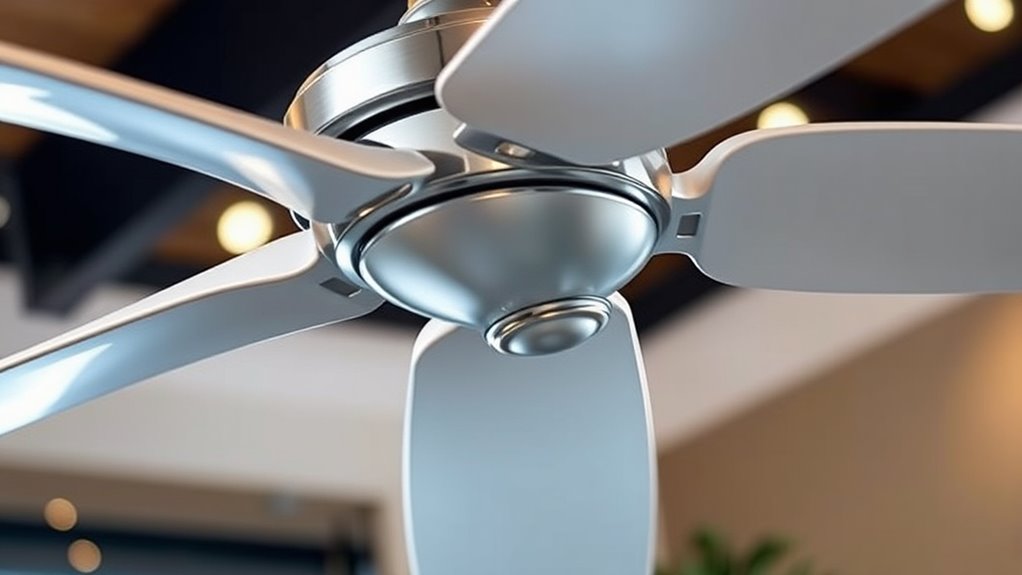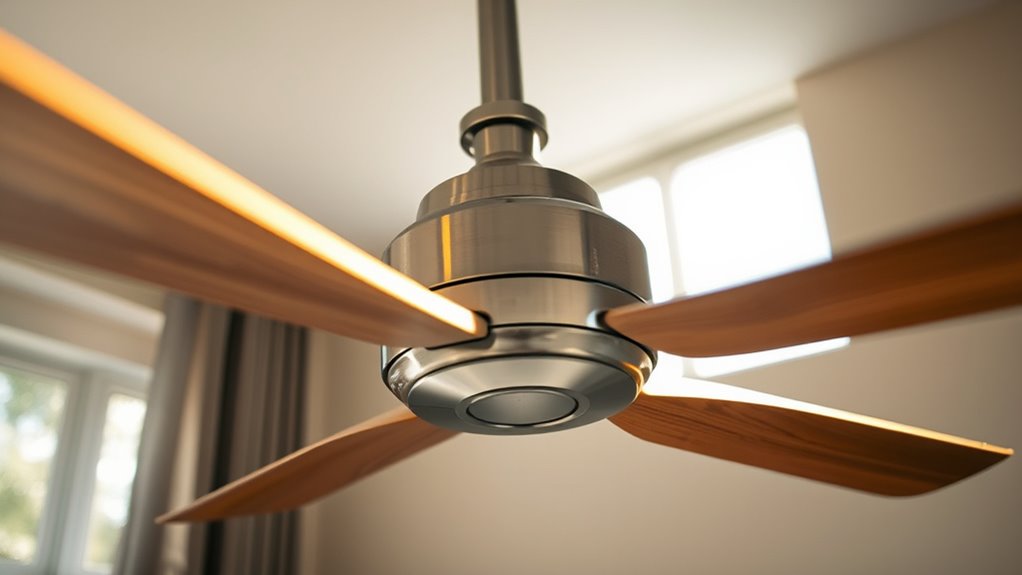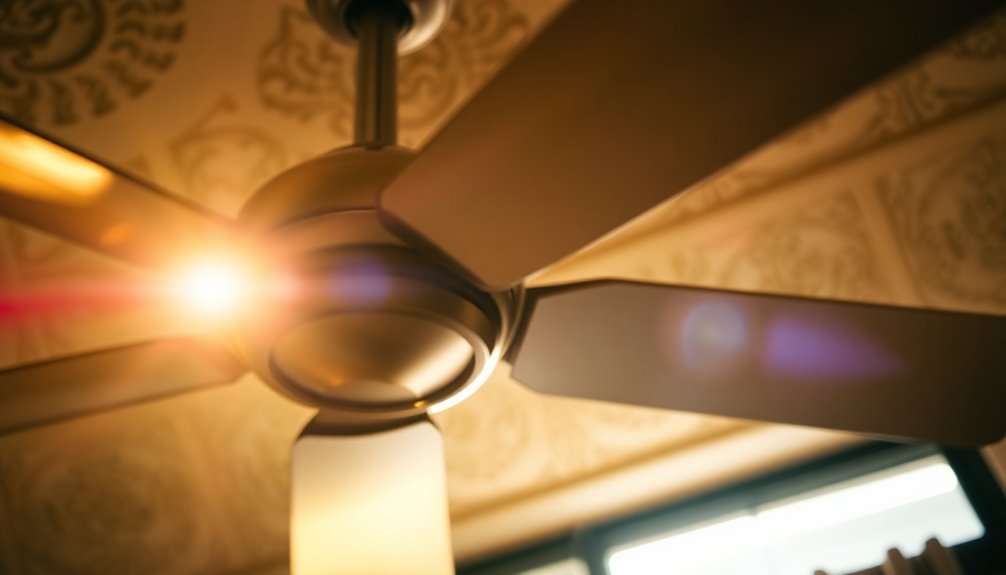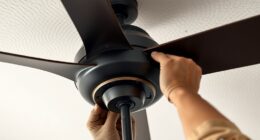Understanding ceiling fan CFM is key to choosing the right fan for your space. CFM measures how much air a fan moves per minute, affecting how well it cools and circulates air. Larger rooms need fans with higher CFM ratings, while smaller areas require less. Factors like fan size, blade design, and room size influence CFM. To optimize comfort and efficiency, selecting the correct CFM is essential—continue exploring to learn how to find the perfect match for your space.
Key Takeaways
- CFM measures the volume of air a ceiling fan moves per minute; higher CFM means better air circulation.
- Fan size, blade pitch, and design directly influence CFM ratings and airflow efficiency.
- Match fan CFM to room size: smaller rooms need lower CFM, larger spaces require higher CFM for comfort.
- Proper installation and maintenance are essential to ensure the fan performs at its rated CFM.
- High CFM fans are ideal for large or outdoor spaces, providing effective cooling and air distribution.
What Is CFM and Why Is It Important for Ceiling Fans

Understanding what CFM is and why it matters can help you choose a ceiling fan that effectively cools your space. CFM, or cubic feet per minute, measures the airflow a fan generates in one minute, directly impacting its cooling power. A higher CFM indicates a greater fan capacity to circulate air, which is especially important for larger rooms. Being aware of local insights can also guide you in selecting the right fan for your specific environment. If you have a spacious area, you’ll want a fan with a higher CFM rating to ensure adequate airflow and comfort, as fan performance varies significantly based on the CFM value. Additionally, understanding air circulation can help optimize your cooling system for energy efficiency and comfort. Properly matching the CFM to your room size ensures energy efficiency, preventing overuse of power in smaller spaces. Conversely, smaller rooms may require fans with lower CFM values, and considering insulation can further enhance cooling effectiveness.
How CFM Is Measured and Rated in Ceiling Fans

Ceiling fans have their CFM ratings measured by determining how much air they move in cubic feet per minute, usually at their highest speed setting. This CFM rating is established through standardized testing, ensuring consistent comparisons across models. Creating a comfortable bedroom ambience can also influence fan performance by promoting better air circulation and overall comfort. Factors like blade pitch, blade size, and motor power influence the fan’s airflow, directly affecting its CFM value. Manufacturers include these ratings in product details to help you evaluate airflow efficiency. A higher CFM indicates greater airflow, but it also depends on the fan’s blade design and pitch, which optimize the fan’s airflow performance. Additionally, airflow efficiency can be improved by considering the fan’s placement and room size to achieve optimal circulation. Understanding how fan design factors impact CFM can help you select the most effective fan for your space. Moreover, integrating geothermal heat pumps with proper airflow management can enhance overall indoor climate control and energy efficiency. Proper installation and maintenance also play a critical role in maintaining optimal fan performance, ensuring consistent airflow over time.
Typical CFM Ranges and What They Signify

Understanding typical CFM ranges helps you choose the right fan for your space. Smaller fans around 1,000 to 2,000 CFM are perfect for compact rooms. Local favorites often feature outdoor seating, making them ideal for breezy areas. Larger models over 8,000 CFM suit big areas. Knowing these numbers guarantees you get effective airflow where and when you need it, especially when considering headphone compatibility, which can influence your overall comfort and experience.
Common CFM Values
Have you ever wondered what different CFM ratings mean for your ceiling fan’s performance? Typically, ceiling fans range from about 1,000 CFM for small fans to over 10,000 CFM for larger models.
A standard residential fan usually falls between 4,000 and 7,000 CFM, providing adequate airflow for most rooms.
Fan size plays a role: smaller fans with 20-inch blades tend to have around 1,000 CFM, while larger, 60-inch fans can exceed 10,000 CFM.
Fans designed for outdoor or large spaces often have higher CFM ratings, sometimes above 8,000.
Room Size Recommendations
Choosing the right CFM rating for your ceiling fan depends largely on the size of the room you want to cool. For small bedrooms, a fan with around 2,000 CFM typically provides adequate air circulation. Medium-sized rooms, like living rooms with 8-foot ceilings, generally need a fan rated between 4,000 and 5,000 CFM for effective cooling. Larger rooms or spaces with high ceilings benefit from fans with 5,000 to 7,000 CFM to ensure proper airflow. For outdoor areas or very large spaces, you should select fans with 8,000 to 10,000+ CFM to maintain comfort. Matching the CFM rating to your room size helps optimize cooling efficiency and comfort, especially in large rooms requiring more substantial air circulation. Additionally, understanding the safety features of electric fans can help prevent hazards and ensure safe operation in your space. Properly rated fans with appropriate airflow levels contribute to energy efficiency and reduce strain on the motor, increasing longevity. When selecting a fan, consider the type of motor as well, since it influences both performance and durability.
How CFM Ratings Vary Based on Fan Size and Design

You’ll notice that larger fans with bigger blades tend to have higher CFM ratings, making them ideal for spacious areas. The design features, like blade pitch and shape, also influence airflow, with steeper angles boosting CFM. Additionally, the fan size must match the room size to guarantee effective airflow and comfort. Proper airflow management can enhance overall comfort levels and energy efficiency in your space.
Blade Size and Airflow
The size and design of ceiling fan blades play a crucial role in determining their airflow capabilities. Larger blade sizes increase airflow because they move more air with each rotation. Lesser-known spots provide tranquil environments for outdoor activities, which can be ideal for testing your fan’s airflow in open spaces. The shape and pitch of the fan blades also impact CFM, with steeper angles and contoured designs boosting airflow. Additionally, blade material can influence durability and noise levels, indirectly affecting overall performance. The blade pitch angle is especially important because it determines how much air the blades can push; steeper pitches generally move more air and increase CFM. Consider these factors:
- Bigger blades = higher airflow (CFM)
- Longer blades cover more area
- Blade shape influences efficiency
- Design details like pitch and contour affect fan performance
Design and Blade Pitch
The design elements of ceiling fans, especially blade pitch and shape, have a direct impact on their airflow performance. Blade pitch, measured in degrees, determines how steeply the blades are angled, with steeper pitches (around 12-15°) moving more air than flatter ones.
Blade shape also plays a vital role; aerodynamic, contoured blades reduce drag and enhance airflow efficiency. Fan design influences how effectively air is displaced, with larger fans and longer blades generally producing higher CFM ratings because they move more air per revolution.
Conversely, fans with lower blade pitch or smaller sizes generate less airflow, making them suitable for smaller spaces. Overall, variations in blade pitch, shape, and fan design cause notable differences in CFM ratings across different models.
Fan Size and Room Fit
Choosing the right ceiling fan size is essential for achieving ideal airflow in your space. Your room fit depends on selecting a fan size that matches your area. Larger fans with bigger blade spans, like 52″ or 60″, typically generate higher CFM ratings (over 5,000), perfect for spacious rooms. Smaller fans, such as 20″ or 24″, produce lower CFM ratings (around 1,000–2,000), suitable for compact areas.
Keep in mind:
- Bigger fans move more air, increasing ceiling fan airflow.
- Blade shape and pitch influence CFM, enhancing efficiency.
- Longer and wider blades move more air but need stronger motors.
- Matching fan size to room size maximizes airflow and comfort.
- Proper installation and fan efficiency can further improve airflow performance. Additionally, selecting a fan with appropriate blade pitch can significantly impact its airflow capacity.
Choosing appropriately sized fans ensures adequate CFM ratings and effective room cooling.
Determining the Ideal CFM for Different Room Sizes

Selecting the right ceiling fan CFM depends on the size of your room to guarantee effective airflow and comfort. For small rooms (less than 12’x12’), around 1,000 CFM suffices. Medium-sized rooms (up to 15’x15’) need between 2,000 and 3,000 CFM. Larger rooms (around 20’x20’) benefit from fans rated 3,000 to 4,000 CFM. Outdoor spaces or very large rooms require 8,000 to 10,000+ CFM for proper air circulation. To help you decide, here’s a quick visual guide:
| Room Size | Recommended CFM Range | Example Room |
|---|---|---|
| Small | ~1,000 CFM | Bedroom |
| Medium | 2,000-3,000 CFM | Living Room |
| Large | 3,000-4,000 CFM | Dining Area |
| Extra Large | 8,000+ CFM | Outdoors |
The Relationship Between CFM and Air Velocity

Understanding how CFM relates to air velocity helps you gauge how effectively a ceiling fan cools a space. A high CFM indicates more air movement overall, but air velocity determines how fast that air feels.
High CFM means more air movement, but air velocity affects how cool and breezy it feels.
Keep in mind:
- A fan with high CFM can move a large volume of air, but the air velocity might be moderate.
- Blade pitch influences both CFM and air velocity by affecting the air movement pattern.
- Larger fans tend to have higher CFM but don’t always produce faster air velocity.
- The perceived cooling effect depends on air velocity, creating a breeze that enhances comfort regardless of CFM.
Ultimately, understanding this relationship helps you choose a fan that balances air volume and velocity for superior cooling.
Factors That Influence a Fan’s CFM Performance

Several key factors directly impact a ceiling fan’s CFM performance. Blade pitch, or the angle of the blades, plays a vital role—steeper pitches generally boost airflow and increase CFM.
Blade size and length also matter; larger blades cover more area, generating higher airflow. The design and shape of the blades, like aerodynamic profiles, influence how efficiently air is displaced, affecting overall fan’s efficiency.
Additionally, the motor’s power and speed (RPM) determine how quickly the blades spin, directly impacting airflow volume. Blade material and weight can influence blade speed and stability, further affecting the fan’s ability to maintain ideal CFM output.
Selecting Fans With the Appropriate CFM for Your Space

Choosing the right ceiling fan CFM depends on your room’s size and layout. To guarantee optimal air circulation, select a fan with a CFM rating that matches your space.
Selecting the right ceiling fan CFM ensures optimal airflow tailored to your room’s size and layout.
For small rooms up to 12’x12’, a fan with around 1,000 CFM suffices.
Medium-sized rooms, about 15’x15’, need fans rated between 2,000 and 3,000 CFM.
Larger rooms over 20’x20’ require fans with 3,000 to 4,000+ CFM for proper airflow.
Outdoor areas or big commercial spaces often need fans exceeding 8,000 CFM to keep air moving effectively.
Always match your room size and ceiling height with the recommended CFM range to maximize comfort, air circulation, and energy efficiency.
Picking the correct CFM ensures your ceiling fan works best for your space.
Benefits of High CFM Fans and When to Use Them

High CFM fans are perfect for large spaces or outdoor areas where strong airflow is needed to keep everyone comfortable.
They can cut energy costs by reducing the need for air conditioning in big rooms.
When your space is expansive or crowded, a high CFM fan guarantees effective ventilation and cooling.
Effective for Large Spaces
When you need to cool large spaces efficiently, fans with high CFM ratings are your best option. These high CFM ceiling fans, often exceeding 8,000 to 10,000 CFM, are designed specifically for large areas like open-plan living rooms, gyms, or outdoor patios.
They excel at:
- Maximizing air circulation across vast spaces
- Cooling large rooms quickly and evenly
- Reducing reliance on air conditioning, saving energy
- Maintaining consistent air movement, preventing stagnant zones
Using high CFM fans in large spaces boosts fan efficiency by distributing air thoroughly, which helps lower room temperatures more effectively. This ensures a comfortable environment, even in extensive areas, without sacrificing performance or stability.
Reduces Energy Costs
Have you considered how high CFM ceiling fans can cut your energy costs? These fans improve airflow efficiency, especially in large spaces, reducing your reliance on air conditioning.
By circulating air more effectively, high CFM fans allow you to set higher thermostat temperatures while keeping your environment comfortable. Although they may consume more power, their enhanced airflow means you spend less on climate control overall.
In outdoor or expansive indoor areas, high CFM fans distribute air evenly, minimizing the need for costly cooling systems. Properly selected high CFM fans help maintain comfortable temperatures while lowering your energy bills.
When used appropriately, they’re a smart investment that saves you money in the long run without sacrificing comfort.
Tips for Improving Airflow and Maximizing Fan Efficiency

To enhance airflow and maximize your ceiling fan’s efficiency, start by ensuring the blades have the proper pitch, typically between 12 and 15 degrees, which considerably boosts CFM without extra power. Proper blade pitch improves airflow efficiency, so check and adjust if needed.
Ensure ceiling fan blades have a 12–15 degree pitch to boost airflow and efficiency.
Additionally, consider these tips:
- Match fan size to your room—larger blades in bigger spaces increase airflow.
- Install the fan centrally to promote even circulation.
- Keep blades and motor components clean to reduce drag.
- Use fans with aerodynamically designed blades for better airflow and quieter operation.
These adjustments optimize fan performance, improve airflow, and save energy, making your ceiling fan more effective year-round.
Frequently Asked Questions
What Is Considered a Good CFM for a Ceiling Fan?
A good CFM for your ceiling fan depends on your room size. For standard rooms with 8-foot ceilings, aim for 4,000 to 7,000 CFM to guarantee proper airflow.
If your space is smaller, around 3,000 CFM might suffice. But larger rooms benefit from 8,000 CFM or more.
Choosing the right CFM helps you stay comfortable while saving energy and maintaining efficient cooling or ventilation.
Is 4000 CFM a Lot for a Fan?
Thinking about whether 4,000 CFM is a lot, it’s like asking if a gentle breeze is enough—depends on your space.
For a small or medium room, that airflow is usually just right, offering a comfortable breeze without overpowering.
In larger areas, it’s more of a steady, reliable flow rather than an overwhelming gust.
What Does 8000 CFM Mean on a Ceiling Fan?
When you see 8,000 CFM on a ceiling fan, it means the fan moves 8,000 cubic feet of air each minute. This high airflow is perfect for large spaces or outdoor areas needing strong ventilation.
You’ll notice better air circulation and cooling, especially in rooms over 300 square feet. It’s a powerful fan designed for commercial or outdoor use, providing maximum airflow to keep the environment comfortable.
Is Higher CFM Better for My Fan?
When you ask if higher CFM is better, think of it as moving more air, cooling more effectively, and covering larger areas.
But, you also need to take into account energy use, noise, and room size.
A higher CFM can be beneficial for bigger spaces, but for smaller rooms, it might be unnecessary or inefficient.
Conclusion
Think of your ceiling fan as a dance partner, guiding the air with every move. Just like choosing the right partner makes the dance smooth, selecting the correct CFM guarantees your room stays comfortable. Whether you’re cooling a cozy bedroom or a large living area, understanding CFM helps you make the best choice. When you match fan power to your space, it’s like a well-choreographed routine—effortless, efficient, and perfectly in sync.









